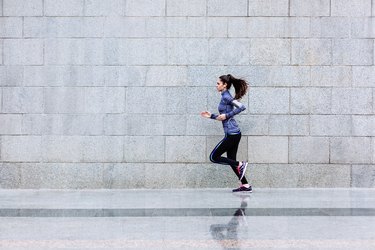
Knowing that you should exercise is sometimes just not enough motivation. Think about the long- and short-term effects of exercise on the respiratory system as well as on your heart and muscle function. A well-thought workout plan will also benefit your waistline, so go ahead and give it a try.
Exercise Lowers Resting Heart Rate
Video of the Day
The cardiovascular system consists of your heart and all of your blood vessels — veins, arteries and capillaries. It is also known as the circulatory system or the blood-vascular system. Its role is to maintain homeostasis, a stable internal environment.
Video of the Day
Read more: 10 Cool Facts About Your Heart
Your blood vessels carry blood and nutrients to every tissue and cell in the body. If one part of the system doesn't work properly, it can affect your health on every level.
Your heart has a full-time job. If it is not strong, you know it and you can't function properly. Every minute, the heart pumps somewhere between about 60 and 100 times, according to the Cleveland Clinic. If it beats 80 times per minute, that's 115,200 beats per day.
Regular exercise strengthens your heart so it doesn't have to pump as much, according to a December 2018 review published in the Journal of Clinical Medicine. In the long run, physical activity may increase your lifespan and improve cardiovascular function. In one study, older adults who engaged in regular exercise experienced an 8.4 percent reduction in resting heart rate.
Read more: Exercise & Heart Rate Experiments
As the review authors point out, there is a strong relationship between resting heart rate and life expectancy. An increase in resting heart rate by just 10 beats per minute may increase the risk of death by a staggering 17 percent.
Improved Stroke Volume
Stroke volume is the amount of blood pumped with each beat of your heart. It is measured in milliliters of blood per beat.
Every time your heart beats, blood is ejected from the left ventricle and out into your blood vessels. Each beat pushes that blood throughout your body, carrying oxygen-rich blood to tissues.
Regular exercise improves the strength of your heart. This translates into stronger contractions that pump more blood with every beat.
As the Centers for Disease Control and Prevention notes, physical activity has a direct impact on stroke volume, among other cardiovascular markers. If you exercise regularly, your heart will work more efficiently and not as hard as it used to.
But that's not all. Regular exercise has been shown to decrease blood pressure, improve blood lipids and reduce heart disease risk. Furthermore, it increases good cholesterol levels and endothelial dysfunction, leading to better cardiovascular health. In the long run, an active lifestyle can protect against coronary artery calcification and circulatory disorders.
Capillary Density and Gas Exchange
Capillaries are the tiny blood vessels that branch off of bigger veins and arteries. They permeate organs and other tissues so that all cells and organs can get the nutrients they need.
Over time, physical activity helps increase capillary density, according to a review featured in the Journal of Physiology in April 2015. This means your body gets more efficient at taking out waste products like carbon dioxide and uses the oxygen-rich blood more effectively. It also starts to work better at a cellular level and your overall health improves.
So, what are you waiting for? It's never too late to start working out. All you need is some motivation and discipline. Find an activity you enjoy, come up with an exercise plan and stick to it.
Remember, any exercise is better than none. If you have a busy lifestyle, squeeze mini exercise sessions into your routine. Start the day with yoga, take a brisk walk after lunch and do bodyweight exercise or hit the gym after work.
- Centers for Disease Control and Prevention: "Physiologic Responses and Long-Term Adaptations to Exercise"
- Cleveland Clinic: "Pulse and Target Heart Rate"
- Khan Academy: "The Circulatory System Review"
- NCBI: "A Physiologist's View of Homeostasis"
- MDPI: "Effects of Exercise on the Resting Heart Rate: A Systematic Review and Meta-Analysis of Interventional Studies"
- BioMed Research International: "Relationship Between Stroke Volume and Pulse Pressure During Blood Volume Perturbation: A Mathematical Analysis"
- Journal of Physiology: "The Effect of Different Training Modes on Skeletal Muscle Microvascular Density and Endothelial Enzymes Controlling NO Availability"
- NCBI: "Cardiovascular Effects and Benefits of Exercise"